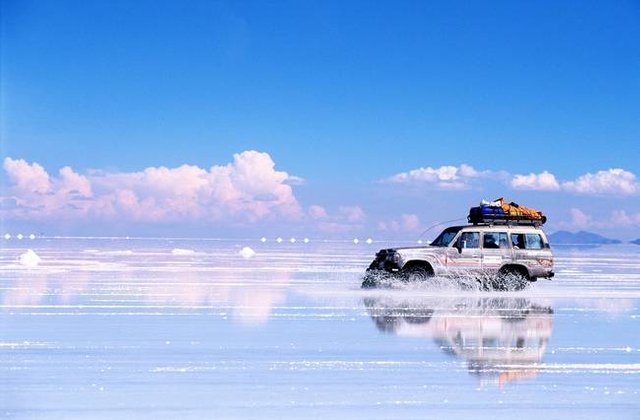In the middle of southwest Bolivia sits a massive, 4,000 square mile patch of salt flats. In the summer, it's a prime source of lithium and salt, but during the flooding season, it transforms into something really incredible: the world's largest mirror.


Located near the crest of the Andes, Bolivia Salt Flats, known locally as the Salar de Uyuni, is the result of thousands of years of transformations that took place between several prehistoric lakes. The land is covered with a few meters-worth of salt brine that creates a stunningly flat surface. When it rains, this flat surface forms an incredible "mirror" that is so big, and so reflective, that governments actually focus on it to calibrate their satellites!


From wikipedia:
Salt flats are ideal for calibrating the distance measurement equipment of satellites because they are large, stable surfaces with strong reflection, similar to that of ice sheets. As the largest salt flat on Earth, Salar de Uyuni is especially suitable for this purpose. In the low-rain period from April to November, due to the absence of industry and its high elevation, the skies above Salar de Uyuni are very clear, and the air is dry. It has a stable surface which is smoothed by seasonal flooding (water dissolves the salt surface and thus keeps it leveled). As a result, the variation in the surface elevation over the 10,582-square-kilometer (4,086 sq mi) area of Salar de Uyuni is less than 1 meter (3 ft 3 in), and there are few square kilometers on Earth that are as flat. The surface reflectivity (albedo) for ultraviolet light is relatively high at 0.69 and shows variations of only a few percent during the daytime. The combination of all these features makes Salar de Uyuni about five times better for satellite calibration than the surface of an ocean. Using Salar de Uyuni as the target, ICESat has already achieved the short-term elevation measurement accuracy of below 2 centimeters.
The Bolivia Salt Flats are also home to another interesting attraction: a massive, antique train cemetery.

The railroad graveyard sits just about two miles outside the city of Uyuni and is connected to it by the old train tracks. Uyani once served as a major distribution hub for trains carrying mined salt and miners from the flats. The train lines, which were created by British engineers who hoped that Bolivia would begin to flourish with a good transportation system, but the plans went south after constant attacks by the indigenous Indians sabotaged each and every attempt to maintain the tracks and trains.

Eventually, the minerals began to dry up, and with the mounting attacks, the miners packed up and went home, abandoned their trains in the desert where they still sit, rusting in the sun, to this day.